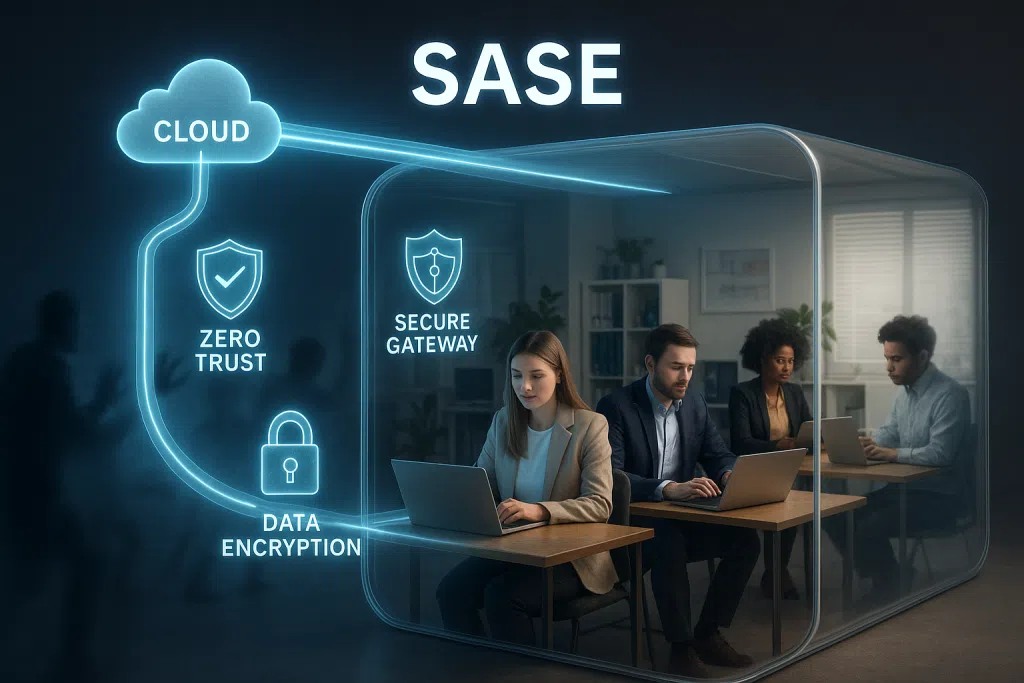Secure Access Service Edge, or SASE, is at the forefront of cybersecurity and network evolution in today’s increasingly cloud-driven world. Yet, many small and mid-sized businesses (SMBs), especially those in regulated industries such as healthcare, finance, legal, and pharmaceuticals, still struggle to fully understand the true SASE meaning and its real-world applications. This article clarifies the concept of SASE, explains its components, explores its benefits for compliance-focused organizations, and offers actionable guidance on selecting and implementing the best SASE solutions. If you want to bridge the knowledge gap between traditional network security and today’s cloud-first expectations, you’re in the right place.
Book an initial Discovery meeting to discuss SASE adoption for your business.
The Core of SASE: Breaking Down Secure Access Service Edge
SASE, pronounced “sassy,” stands for Secure Access Service Edge. This approach merges wide-area networking (WAN) with a comprehensive suite of network security functions, all delivered from the cloud. The concept first appeared in 2019, gaining rapid popularity as organizations accelerated their move to SaaS apps, remote work models, and distributed infrastructure. Unlike traditional perimeter-based security, SASE redefines how access and protection are delivered. It enables businesses to offer secure, policy-driven access to applications, data, and resources, regardless of device, location, or network.
At its heart, SASE represents a major shift in how SMBs manage security and connectivity:
- Networking and Security Convergence: Rather than relying on legacy firewalls and branch office hardware, SASE combines networking (like SD-WAN) and security functions (such as secure web gateways and zero-trust network access) into a unified platform.
- Cloud-native Delivery: All services are delivered directly from the cloud, so users can access resources securely whether they’re in the office, at home, or on the move.
- Policy-based, Identity-aware Access: Every connection is evaluated based on real-time context, user identity, device health, location, and even risk factors, before access is granted.
- Built for the Modern Workplace: As distributed workforces become the norm, SASE helps businesses keep up with the need for flexible, reliable, and secure access everywhere.
To truly grasp the SASE meaning, it helps to look beyond buzzwords. Imagine a law firm where attorneys move between court, home, and office, often handling sensitive client data on their own laptops. Or a healthcare provider that now allows telemedicine visits, with staff using various devices to access patient records. Traditional network “castle and moat” defenses fall short. SASE, on the other hand, enforces security and connectivity based on the specific needs of every user and device, no matter where they are or how they connect.
Key elements of SASE include:
- SD-WAN (Software-Defined Wide Area Networking): Directs traffic along the most efficient path, reduces bottlenecks, and ensures reliable performance.
- Cloud Access Security Broker (CASB): Monitors cloud application use and applies granular security policies.
- Secure Web Gateway (SWG): Filters unsafe content, blocks threats, and regulates web usage.
- Zero Trust Network Access (ZTNA): Ensures users and devices are continuously authenticated before accessing critical resources.
- Firewall as a Service (FWaaS): Delivers advanced firewall protection, but managed from the cloud.
SASE’s holistic approach is no longer an emerging trend. It’s rapidly becoming the baseline for secure access, as shown by Gartner’s continued coverage and SMB adoption statistics. Book an initial Discovery meeting to see how SASE can drive compliance and security for your organization.
The SASE Security Framework: Architecture and Key Components
Understanding the SASE security framework means dissecting both its architecture and its essential building blocks. SASE was designed to address the inefficiencies and security risks of piecemeal solutions, each bolted onto a legacy network. With SASE, different technologies work together as one centrally managed, cloud-delivered system.
How SASE Fits into Modern Network Security
- Unified Management: All security and networking services are maintained through a single cloud console, providing a cohesive policy structure and streamlined operations.
- Distributed Enforcement: Security controls such as threat prevention and data protection are applied close to the user, no matter where they are located, minimizing performance issues and security loopholes.
- Dynamic, Identity-driven Policies: By taking into account user identity, device status, application sensitivity, and threat intelligence, SASE frameworks enforce context-sensitive rules at every access point.
Core Components Explained
- SD-WAN: Replaces traditional WAN hardware, automatically routing traffic across the best available connection, whether that’s broadband, LTE, or MPLS, while securing network traffic using built-in encryption.
- Zero Trust Network Access (ZTNA): Moves away from old-fashioned VPNs, only granting users access to resources for which they have explicit, ongoing permission. Any suspicious device or credential triggers further verification or blocks access outright.
- Secure Web Gateway (SWG): Protects users from unsafe websites, inappropriate content, and malware by enforcing filtering policies and scanning outbound traffic.
- Cloud Access Security Broker (CASB): Implements security controls around SaaS application usage, often a weak point for SMBs handling sensitive data in apps like Microsoft 365 or Google Workspace.
- Firewall as a Service (FWaaS): Offers scalable, cloud-based protection against network intrusions, DDoS attacks, and other threats usually mitigated by on-premises firewalls.
SASE and Cybersecurity Compliance
For organizations in regulated industries, one of SASE’s main attractions is its deep alignment with cybersecurity compliance requirements such as HIPAA, PCI-DSS, or FINRA. Here’s why SASE is especially relevant to compliance-driven SMBs:
- Consistent Enforcement: Policies set at a central point are pushed across all users and devices, reducing the risk of accidental non-compliance.
- Audit Readiness: Logging, monitoring, and alerting features in SASE solutions enable simpler audit trails, making evidence collection for compliance reviews much easier.
- Secure Remote and Third-party Access: With ZTNA and granular policy controls, SMBs can allow contractors, teleworkers, and vendors to access specified data without risking a regulatory violation.
When evaluating the best SASE solutions, it’s crucial to ensure they cover the required compliance mandates for your industry. According to Gartner’s “2025 Market Guide for Single-Vendor SASE”, centralizing security and networking operations not only improves security posture but also streamlines compliance management for regulated businesses.
Why SMBs Need to Consider SASE Network Security
While SASE began as an enterprise-focused concept, its advantages are increasingly relevant to the specific risks and opportunities facing SMBs. Companies in healthcare, legal, financial, and pharmaceutical fields have unique requirements, high-value data, ever-present compliance threats, limited in-house IT resources, and a hybrid workforce.
Real-World SMB Challenges and SASE Solutions
Decentralized Workforces: Remote and hybrid workforces are now the rule rather than the exception. SASE enables secure access to cloud-based and on-premises systems regardless of user location, reducing the reliance on risky VPN endpoints and unsecured connections.
Rampant Shadow IT: Employees often adopt cloud apps without IT approval, creating risk. With SASE, CASB tools provide visibility and control over these applications, helping businesses enforce security and acceptable use policies (even across devices not owned by the company).
Increasing Attack Surface: As office boundaries fade and more data moves to the cloud, SMBs become attractive targets for attackers. SASE delivers uniform security policies and ongoing threat monitoring for all endpoints and users, whether they’re on mobile, desktop, or IoT hardware.
Compliance Requirements: Failure to comply with HIPAA, PCI-DSS, or other industry standards brings heavy penalties. SASE strengthens Cybersecurity compliance by baking controls right into the network fabric and simplifying audit reporting.
Rapid Growth and M&A: Acquisitions and expansions can strain legacy networks. SASE makes it straightforward to onboard new sites, users, or systems thanks to its scalable, cloud-based approach.
The SASE security framework is especially valuable here because it minimizes complexity and brings enterprise-level protection to smaller organizations without requiring massive budgets or endless hardware upgrades.
A recent TechCrunch analysis (2025) highlighted the trend of SMBs redirecting investment away from individual devices and security appliances in favor of unified, cloud-managed SASE solutions. These changes reflect both budgetary realities and the need for protection that fits the new shape of work.
Evaluating the Best SASE Solutions for Regulated Industries
Adopting SASE isn’t as simple as picking a product off the shelf. SMBs, especially those in regulated spaces like healthcare, financial services, and law, need to ask the right questions when weighing options and planning deployments. Here are concrete steps and criteria to follow when evaluating the best SASE solutions for your business.
Key Features to Look For
- Compliance Certifications: Does the SASE provider support HIPAA, PCI-DSS, or other standards relevant to your operations?
- Full Suite of Security Functions: Check for SD-WAN, SWG, FWaaS, CASB, and ZTNA modules, all fully cloud native.
- User and Device Visibility: The solution should provide real-time visibility into user activity, device status, and potential risks.
- Integration with Existing Tools: Can the platform work alongside your current security stack (such as endpoint detection or SIEM tools)?
- Performance Optimization: Look for SD-WAN technology that ensures fast and reliable connections for distributed teams and branch offices.
- Scalable Policy Enforcement: The ability to create, modify, and enforce policies centrally makes life easier for resource-constrained SMB IT teams.
SASE Network Security in Action: Case Example
A multi-office healthcare provider in New Jersey, for example, had relied on VPN tunnels and stand-alone firewall appliances to connect doctors and administrators across three locations and dozens of telework setups. When this provider moved to a SASE solution, it replaced hardware with a cloud-managed system that didn’t just connect users, but inspected traffic, enforced compliance rules, and delivered incident alerts in real time. This transformation reduced mean incident response time by 60% and helped the IT team quickly provide auditors with detailed access records, all without needing to add more full-time IT staff.
Total Cost of Ownership and ROI
One of the main barriers SMBs face is the perceived cost of adopting advanced security platforms. On closer examination, SASE often reduces both direct and indirect expenses:
- No more hardware refresh cycles: With services in the cloud, ongoing capital expenditure on firewalls, VPN concentrators, and related devices becomes unnecessary.
- Lower management overhead: Unified platforms mean less time spent on patching, upgrades, troubleshooting, and policy duplication.
- Reduced compliance penalties: Automated, auditable security controls help prevent the types of data exposures that bring regulatory fines.
- Enhanced productivity: Reliable performance and frictionless access for remote and hybrid users minimize downtime.
A recent Forrester study found that SMBs deploying SASE reported reduced breach recovery costs and higher employee productivity, often within the first year. Book an initial Discovery meeting to evaluate your cost savings and compliance improvements here.
Steps to Successfully Implement the SASE Security Framework
While SASE streamlines both network security and management, successful implementation hinges on careful upfront planning and ongoing oversight. Below are actionable steps SMBs can take to move from legacy environments to a robust SASE deployment:
- Assess Current State: Take stock of your network architecture, legacy hardware, remote user workflows, application dependencies, and regulatory requirements. Engage IT leadership, compliance officers, and key department heads early.
- Define Objectives: Clearly articulate what you want a SASE solution to accomplish. Are you aiming for better remote access security, easier compliance audits, or network performance improvements? Setting clear goals ensures better alignment with both vendors and internal teams.
- Select SASE Providers: Compare vendors by evaluating their Cybersecurity compliance features, integration options, and customer support track records. Consider local MSP partners experienced in regulated SMB environments.
- Design and Plan Rollout: Decide whether to migrate all users at once or phase by site, function, or business unit. Pilot programs can help identify unforeseen issues without jeopardizing business operations.
- Integrate with Existing Security Tools: While SASE brings many functions together, most SMBs have existing investments in endpoint security, SIEM, or backup. Strong solutions integrate cleanly or at least avoid duplication.
- Educate Stakeholders: Empower users and IT personnel with clear guidelines about new workflows, policies, and access processes. This bolsters both user buy-in and security effectiveness.
- Monitor, Optimize, and Iterate: Use your SASE dashboard to watch for policy violations, performance bottlenecks, or missed compliance steps. Regular reviews ensure the security framework remains a living, adaptable system.
Consider a law firm transitioning to SASE: By identifying which partners require access to only specific document sets and rapidly provisioning cloud-based controls, the IT team prevented unauthorized sharing, reduced cost, and satisfied client confidentiality mandates faster.
A successful transition doesn’t stop at initial deployment. Ongoing optimization and continuous policy reviews make SASE a living part of Cybersecurity compliance, one able to grow as operations, regulations, and attack methods evolve.
SASE for Compliance, Productivity, and the Future of IT Security
The SASE meaning goes far beyond simple technology. It signals a new way of thinking about secure access, flexible, cloud-based, and deeply integrated with compliance and policy needs. For SMBs in regulated sectors, SASE network security provides a pathway to tackle familiar pain points: from outdated, expensive firewalls and dicey VPN connections to ongoing audit headaches and risk from remote work.
By unifying WAN management, zero-trust access, threat detection, web filtering, and app control within a single, adaptable system, SASE helps organizations build a future-ready foundation. Key takeaways for SMBs interested in SASE:
- Accelerates Digital Transformation: Enables use of cloud, AI, and edge tools without additional risk.
- Reduces Hands-On IT Management: Allows smaller IT teams to manage security and access in a centralized, efficient way.
- Strengthens Audit and Compliance Posture: Provides the trackable, automated controls auditors expect.
- Supports Flexible Work Models: Delivers fast, secure access to resources no matter where your teams operate.
As cybersecurity threats become more frequent and complex, waiting to modernize network security simply isn’t an option for businesses handling confidential client or patient data. SASE not only raises the bar for protection, it does so in a cost-effective, cloud-native manner that actually simplifies daily operations and compliance.
Want to know more about implementing SASE for your organization’s specific risks and opportunities? Book an initial Discovery meeting to discuss how SASE can transform your security and compliance approach.
Frequently Asked Questions (FAQ) About SASE Meaning and Implementation
SASE stands for Secure Access Service Edge. Unlike traditional network security, which depends on physical firewalls and predefined network “edges,” SASE delivers a unified suite of cloud-managed networking and security services. This enables remote and office-based users to receive the same level of access protection and threat management, regardless of location or device.
SASE consolidates multiple security tools, such as zero-trust access, firewalls, and web gateways, into a single cloud-native platform. This consistency in policy enforcement, logging, and auditability helps regulated organizations more easily meet HIPAA, PCI-DSS, and other Cybersecurity compliance requirements, streamlining evidence gathering for auditors and reducing the risk of non-compliance.
SASE offers cloud-delivered security controls and WAN optimization, allowing employees to access necessary apps and data securely from anywhere. Zero Trust Network Access ensures that only validated users and healthy devices are granted access, minimizing risks associated with public Wi-Fi, home networks, or bring-your-own-device (BYOD) setups.
Small and mid-sized businesses should prioritize providers that offer complete, cloud-native solutions (including SD-WAN, ZTNA, SWG, CASB, and FWaaS), have clear provisions for audited compliance, integrate smoothly with existing tools, and offer strong customer support. Experience with similar regulated industries and local knowledge can also be advantages.
With services delivered via the cloud, SASE eliminates the need for most on-premises security appliances, reduces the patching and hardware refresh cycle, and consolidates management interfaces. This can lead to fewer capital expenditures, streamlined operations for small IT teams, and lower incident recovery costs, all while boosting overall network security and reliability.





